Secondary Science: Working Scientifically Analysis and Critique
VerifiedAdded on 2022/09/06
|9
|2071
|16
Report
AI Summary
This report critically analyzes the concept of 'Working Scientifically' within the context of secondary science education. It begins by defining 'Working Scientifically' and exploring its importance, as defined by the National Curriculum, encompassing the methods, processes, and nature of science. The report then examines the pedagogical strategies employed by the student's placement school, evaluating their approach to 'Working Scientifically' through curriculum documents and observed teaching practices. Various learning theories, including behaviorism and constructivism, particularly the contributions of Piaget and Vygotsky, are discussed in relation to experiential learning models. The report highlights the use of scaffolding, the zone of proximal development, and the importance of multiple representations in the classroom. Additionally, it explores the role of outdoor learning and the application of scientific concepts through hands-on activities, referencing specific examples like field trips and laboratory experiments. Finally, the report suggests how to improve the teaching of WS, emphasizing the importance of lesson planning, teacher demonstrations, and aligning content with curriculum standards and student needs. The report concludes with a strong emphasis on experiential learning and its importance in shaping students' understanding of scientific concepts, as well as the importance of peer-to-peer interactions and practical skills.
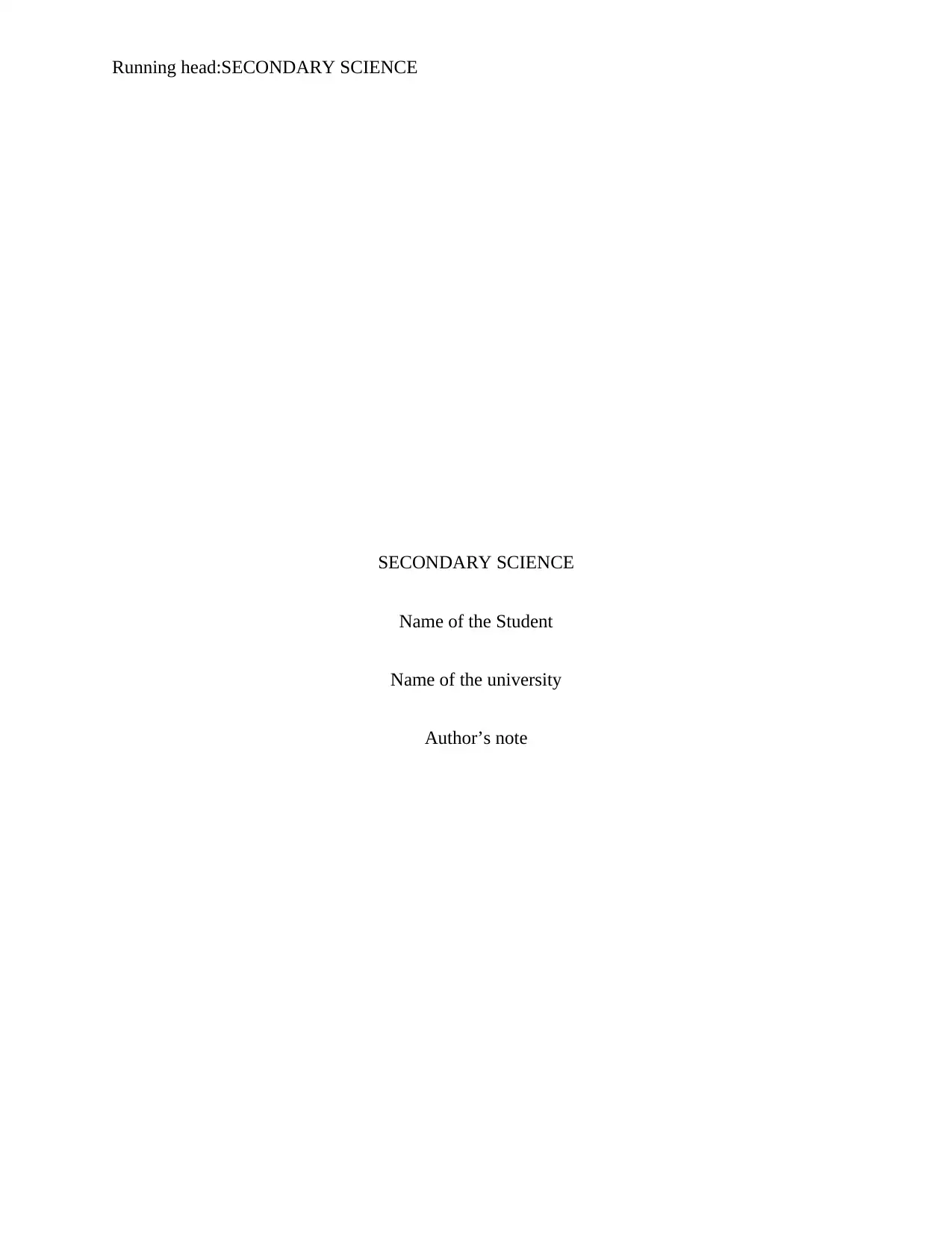
Running head:SECONDARY SCIENCE
SECONDARY SCIENCE
Name of the Student
Name of the university
Author’s note
SECONDARY SCIENCE
Name of the Student
Name of the university
Author’s note
Paraphrase This Document
Need a fresh take? Get an instant paraphrase of this document with our AI Paraphraser
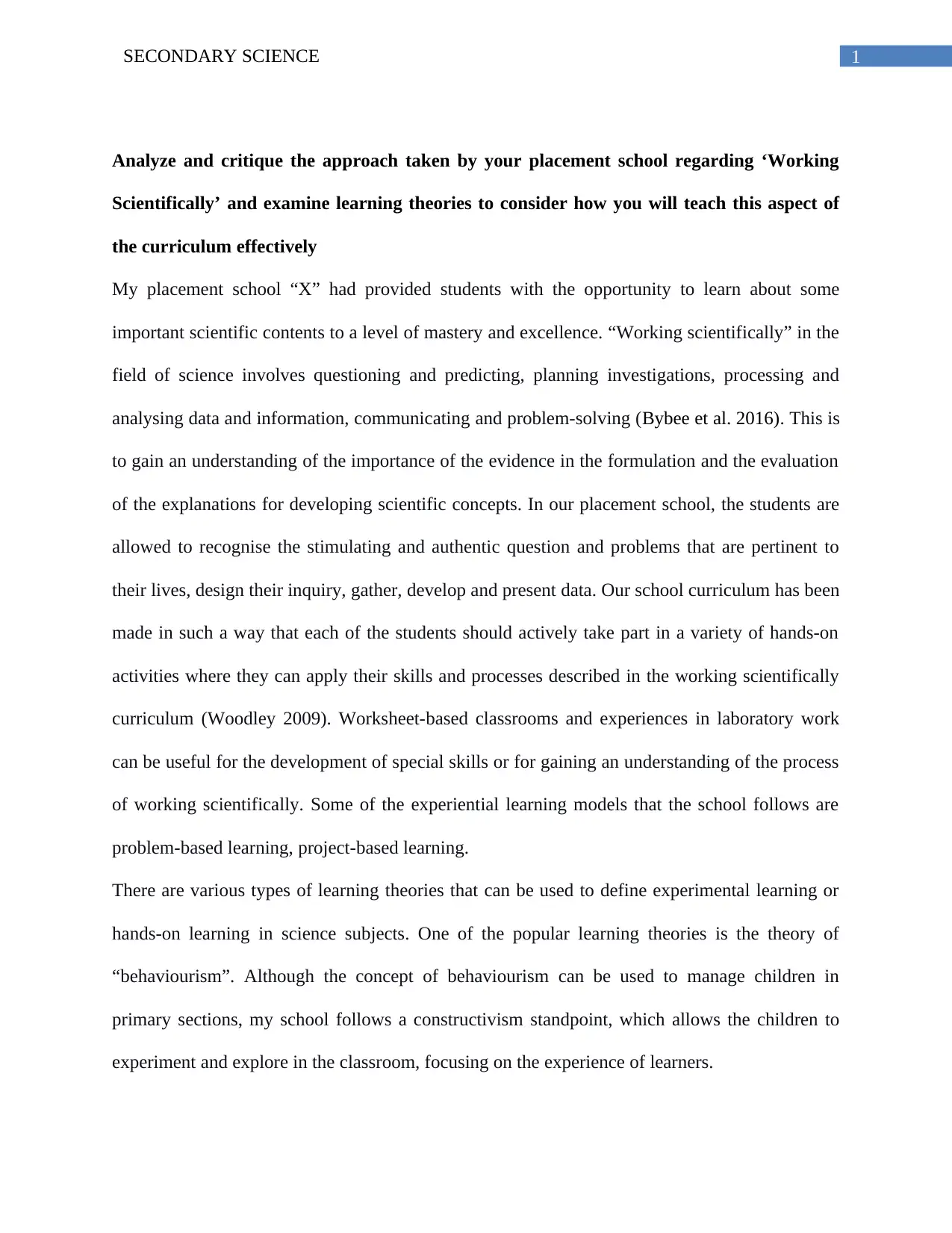
1SECONDARY SCIENCE
Analyze and critique the approach taken by your placement school regarding ‘Working
Scientifically’ and examine learning theories to consider how you will teach this aspect of
the curriculum effectively
My placement school “X” had provided students with the opportunity to learn about some
important scientific contents to a level of mastery and excellence. “Working scientifically” in the
field of science involves questioning and predicting, planning investigations, processing and
analysing data and information, communicating and problem-solving (Bybee et al. 2016). This is
to gain an understanding of the importance of the evidence in the formulation and the evaluation
of the explanations for developing scientific concepts. In our placement school, the students are
allowed to recognise the stimulating and authentic question and problems that are pertinent to
their lives, design their inquiry, gather, develop and present data. Our school curriculum has been
made in such a way that each of the students should actively take part in a variety of hands-on
activities where they can apply their skills and processes described in the working scientifically
curriculum (Woodley 2009). Worksheet-based classrooms and experiences in laboratory work
can be useful for the development of special skills or for gaining an understanding of the process
of working scientifically. Some of the experiential learning models that the school follows are
problem-based learning, project-based learning.
There are various types of learning theories that can be used to define experimental learning or
hands-on learning in science subjects. One of the popular learning theories is the theory of
“behaviourism”. Although the concept of behaviourism can be used to manage children in
primary sections, my school follows a constructivism standpoint, which allows the children to
experiment and explore in the classroom, focusing on the experience of learners.
Analyze and critique the approach taken by your placement school regarding ‘Working
Scientifically’ and examine learning theories to consider how you will teach this aspect of
the curriculum effectively
My placement school “X” had provided students with the opportunity to learn about some
important scientific contents to a level of mastery and excellence. “Working scientifically” in the
field of science involves questioning and predicting, planning investigations, processing and
analysing data and information, communicating and problem-solving (Bybee et al. 2016). This is
to gain an understanding of the importance of the evidence in the formulation and the evaluation
of the explanations for developing scientific concepts. In our placement school, the students are
allowed to recognise the stimulating and authentic question and problems that are pertinent to
their lives, design their inquiry, gather, develop and present data. Our school curriculum has been
made in such a way that each of the students should actively take part in a variety of hands-on
activities where they can apply their skills and processes described in the working scientifically
curriculum (Woodley 2009). Worksheet-based classrooms and experiences in laboratory work
can be useful for the development of special skills or for gaining an understanding of the process
of working scientifically. Some of the experiential learning models that the school follows are
problem-based learning, project-based learning.
There are various types of learning theories that can be used to define experimental learning or
hands-on learning in science subjects. One of the popular learning theories is the theory of
“behaviourism”. Although the concept of behaviourism can be used to manage children in
primary sections, my school follows a constructivism standpoint, which allows the children to
experiment and explore in the classroom, focusing on the experience of learners.
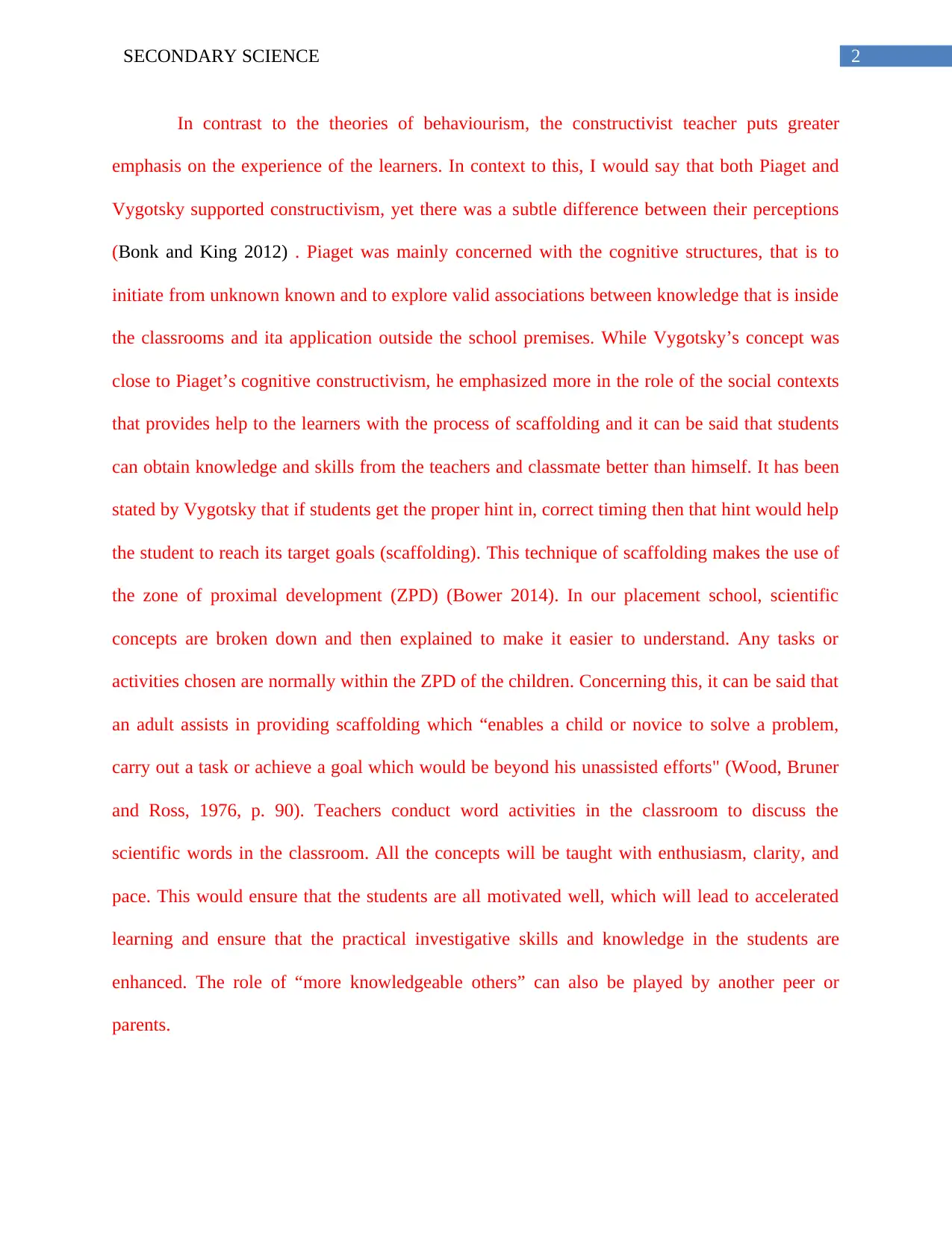
2SECONDARY SCIENCE
In contrast to the theories of behaviourism, the constructivist teacher puts greater
emphasis on the experience of the learners. In context to this, I would say that both Piaget and
Vygotsky supported constructivism, yet there was a subtle difference between their perceptions
(Bonk and King 2012) . Piaget was mainly concerned with the cognitive structures, that is to
initiate from unknown known and to explore valid associations between knowledge that is inside
the classrooms and ita application outside the school premises. While Vygotsky’s concept was
close to Piaget’s cognitive constructivism, he emphasized more in the role of the social contexts
that provides help to the learners with the process of scaffolding and it can be said that students
can obtain knowledge and skills from the teachers and classmate better than himself. It has been
stated by Vygotsky that if students get the proper hint in, correct timing then that hint would help
the student to reach its target goals (scaffolding). This technique of scaffolding makes the use of
the zone of proximal development (ZPD) (Bower 2014). In our placement school, scientific
concepts are broken down and then explained to make it easier to understand. Any tasks or
activities chosen are normally within the ZPD of the children. Concerning this, it can be said that
an adult assists in providing scaffolding which “enables a child or novice to solve a problem,
carry out a task or achieve a goal which would be beyond his unassisted efforts" (Wood, Bruner
and Ross, 1976, p. 90). Teachers conduct word activities in the classroom to discuss the
scientific words in the classroom. All the concepts will be taught with enthusiasm, clarity, and
pace. This would ensure that the students are all motivated well, which will lead to accelerated
learning and ensure that the practical investigative skills and knowledge in the students are
enhanced. The role of “more knowledgeable others” can also be played by another peer or
parents.
In contrast to the theories of behaviourism, the constructivist teacher puts greater
emphasis on the experience of the learners. In context to this, I would say that both Piaget and
Vygotsky supported constructivism, yet there was a subtle difference between their perceptions
(Bonk and King 2012) . Piaget was mainly concerned with the cognitive structures, that is to
initiate from unknown known and to explore valid associations between knowledge that is inside
the classrooms and ita application outside the school premises. While Vygotsky’s concept was
close to Piaget’s cognitive constructivism, he emphasized more in the role of the social contexts
that provides help to the learners with the process of scaffolding and it can be said that students
can obtain knowledge and skills from the teachers and classmate better than himself. It has been
stated by Vygotsky that if students get the proper hint in, correct timing then that hint would help
the student to reach its target goals (scaffolding). This technique of scaffolding makes the use of
the zone of proximal development (ZPD) (Bower 2014). In our placement school, scientific
concepts are broken down and then explained to make it easier to understand. Any tasks or
activities chosen are normally within the ZPD of the children. Concerning this, it can be said that
an adult assists in providing scaffolding which “enables a child or novice to solve a problem,
carry out a task or achieve a goal which would be beyond his unassisted efforts" (Wood, Bruner
and Ross, 1976, p. 90). Teachers conduct word activities in the classroom to discuss the
scientific words in the classroom. All the concepts will be taught with enthusiasm, clarity, and
pace. This would ensure that the students are all motivated well, which will lead to accelerated
learning and ensure that the practical investigative skills and knowledge in the students are
enhanced. The role of “more knowledgeable others” can also be played by another peer or
parents.
⊘ This is a preview!⊘
Do you want full access?
Subscribe today to unlock all pages.

Trusted by 1+ million students worldwide
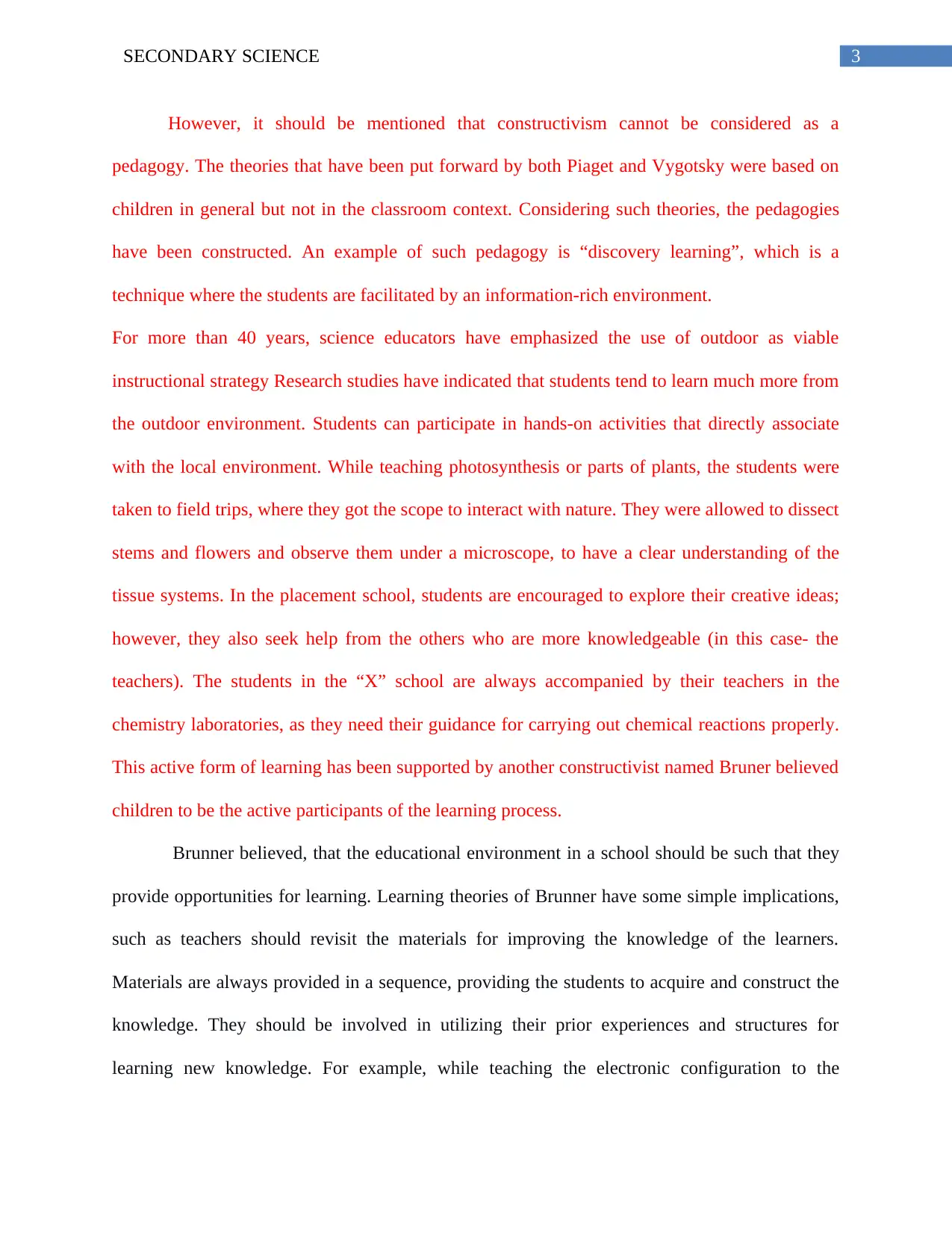
3SECONDARY SCIENCE
However, it should be mentioned that constructivism cannot be considered as a
pedagogy. The theories that have been put forward by both Piaget and Vygotsky were based on
children in general but not in the classroom context. Considering such theories, the pedagogies
have been constructed. An example of such pedagogy is “discovery learning”, which is a
technique where the students are facilitated by an information-rich environment.
For more than 40 years, science educators have emphasized the use of outdoor as viable
instructional strategy Research studies have indicated that students tend to learn much more from
the outdoor environment. Students can participate in hands-on activities that directly associate
with the local environment. While teaching photosynthesis or parts of plants, the students were
taken to field trips, where they got the scope to interact with nature. They were allowed to dissect
stems and flowers and observe them under a microscope, to have a clear understanding of the
tissue systems. In the placement school, students are encouraged to explore their creative ideas;
however, they also seek help from the others who are more knowledgeable (in this case- the
teachers). The students in the “X” school are always accompanied by their teachers in the
chemistry laboratories, as they need their guidance for carrying out chemical reactions properly.
This active form of learning has been supported by another constructivist named Bruner believed
children to be the active participants of the learning process.
Brunner believed, that the educational environment in a school should be such that they
provide opportunities for learning. Learning theories of Brunner have some simple implications,
such as teachers should revisit the materials for improving the knowledge of the learners.
Materials are always provided in a sequence, providing the students to acquire and construct the
knowledge. They should be involved in utilizing their prior experiences and structures for
learning new knowledge. For example, while teaching the electronic configuration to the
However, it should be mentioned that constructivism cannot be considered as a
pedagogy. The theories that have been put forward by both Piaget and Vygotsky were based on
children in general but not in the classroom context. Considering such theories, the pedagogies
have been constructed. An example of such pedagogy is “discovery learning”, which is a
technique where the students are facilitated by an information-rich environment.
For more than 40 years, science educators have emphasized the use of outdoor as viable
instructional strategy Research studies have indicated that students tend to learn much more from
the outdoor environment. Students can participate in hands-on activities that directly associate
with the local environment. While teaching photosynthesis or parts of plants, the students were
taken to field trips, where they got the scope to interact with nature. They were allowed to dissect
stems and flowers and observe them under a microscope, to have a clear understanding of the
tissue systems. In the placement school, students are encouraged to explore their creative ideas;
however, they also seek help from the others who are more knowledgeable (in this case- the
teachers). The students in the “X” school are always accompanied by their teachers in the
chemistry laboratories, as they need their guidance for carrying out chemical reactions properly.
This active form of learning has been supported by another constructivist named Bruner believed
children to be the active participants of the learning process.
Brunner believed, that the educational environment in a school should be such that they
provide opportunities for learning. Learning theories of Brunner have some simple implications,
such as teachers should revisit the materials for improving the knowledge of the learners.
Materials are always provided in a sequence, providing the students to acquire and construct the
knowledge. They should be involved in utilizing their prior experiences and structures for
learning new knowledge. For example, while teaching the electronic configuration to the
Paraphrase This Document
Need a fresh take? Get an instant paraphrase of this document with our AI Paraphraser
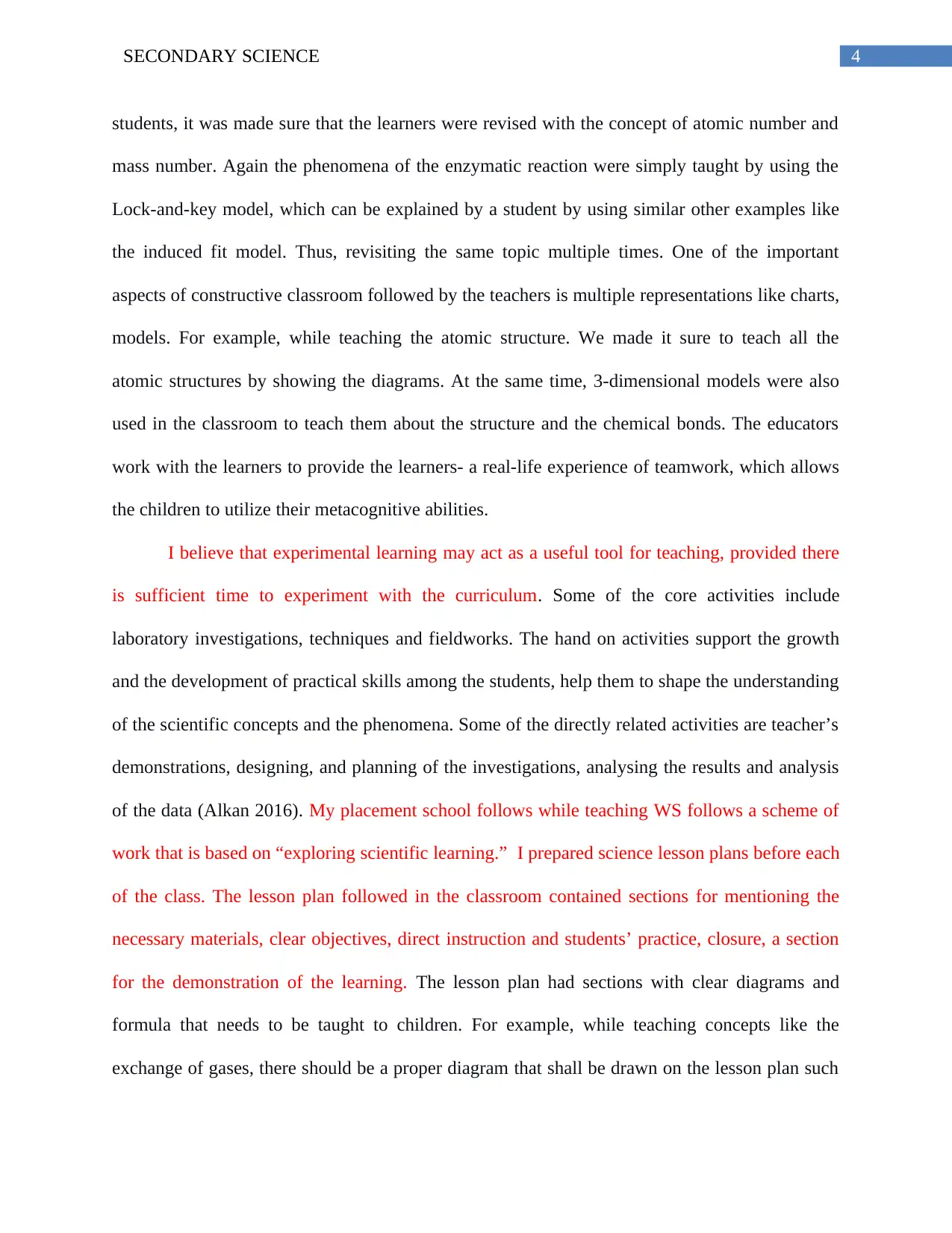
4SECONDARY SCIENCE
students, it was made sure that the learners were revised with the concept of atomic number and
mass number. Again the phenomena of the enzymatic reaction were simply taught by using the
Lock-and-key model, which can be explained by a student by using similar other examples like
the induced fit model. Thus, revisiting the same topic multiple times. One of the important
aspects of constructive classroom followed by the teachers is multiple representations like charts,
models. For example, while teaching the atomic structure. We made it sure to teach all the
atomic structures by showing the diagrams. At the same time, 3-dimensional models were also
used in the classroom to teach them about the structure and the chemical bonds. The educators
work with the learners to provide the learners- a real-life experience of teamwork, which allows
the children to utilize their metacognitive abilities.
I believe that experimental learning may act as a useful tool for teaching, provided there
is sufficient time to experiment with the curriculum. Some of the core activities include
laboratory investigations, techniques and fieldworks. The hand on activities support the growth
and the development of practical skills among the students, help them to shape the understanding
of the scientific concepts and the phenomena. Some of the directly related activities are teacher’s
demonstrations, designing, and planning of the investigations, analysing the results and analysis
of the data (Alkan 2016). My placement school follows while teaching WS follows a scheme of
work that is based on “exploring scientific learning.” I prepared science lesson plans before each
of the class. The lesson plan followed in the classroom contained sections for mentioning the
necessary materials, clear objectives, direct instruction and students’ practice, closure, a section
for the demonstration of the learning. The lesson plan had sections with clear diagrams and
formula that needs to be taught to children. For example, while teaching concepts like the
exchange of gases, there should be a proper diagram that shall be drawn on the lesson plan such
students, it was made sure that the learners were revised with the concept of atomic number and
mass number. Again the phenomena of the enzymatic reaction were simply taught by using the
Lock-and-key model, which can be explained by a student by using similar other examples like
the induced fit model. Thus, revisiting the same topic multiple times. One of the important
aspects of constructive classroom followed by the teachers is multiple representations like charts,
models. For example, while teaching the atomic structure. We made it sure to teach all the
atomic structures by showing the diagrams. At the same time, 3-dimensional models were also
used in the classroom to teach them about the structure and the chemical bonds. The educators
work with the learners to provide the learners- a real-life experience of teamwork, which allows
the children to utilize their metacognitive abilities.
I believe that experimental learning may act as a useful tool for teaching, provided there
is sufficient time to experiment with the curriculum. Some of the core activities include
laboratory investigations, techniques and fieldworks. The hand on activities support the growth
and the development of practical skills among the students, help them to shape the understanding
of the scientific concepts and the phenomena. Some of the directly related activities are teacher’s
demonstrations, designing, and planning of the investigations, analysing the results and analysis
of the data (Alkan 2016). My placement school follows while teaching WS follows a scheme of
work that is based on “exploring scientific learning.” I prepared science lesson plans before each
of the class. The lesson plan followed in the classroom contained sections for mentioning the
necessary materials, clear objectives, direct instruction and students’ practice, closure, a section
for the demonstration of the learning. The lesson plan had sections with clear diagrams and
formula that needs to be taught to children. For example, while teaching concepts like the
exchange of gases, there should be a proper diagram that shall be drawn on the lesson plan such
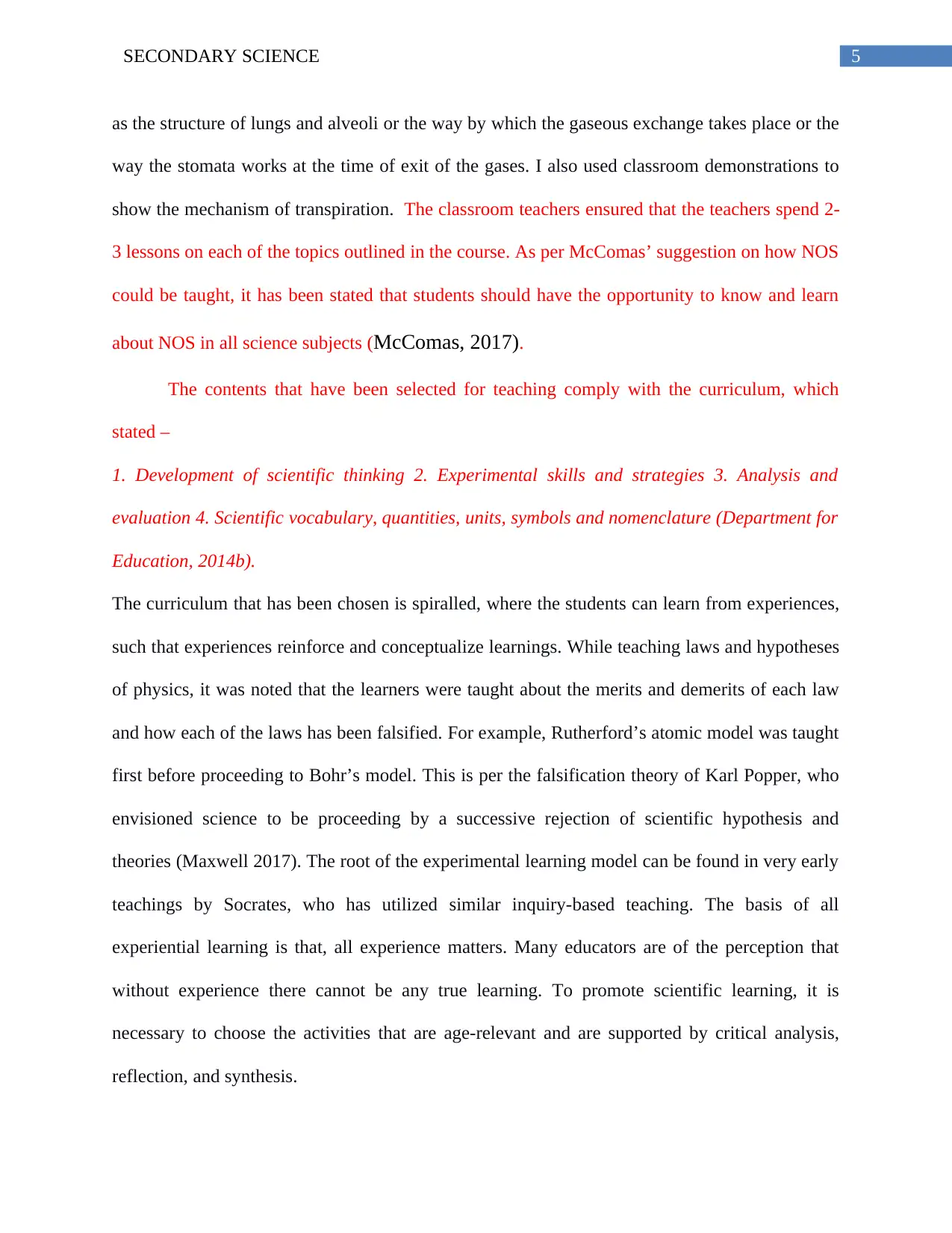
5SECONDARY SCIENCE
as the structure of lungs and alveoli or the way by which the gaseous exchange takes place or the
way the stomata works at the time of exit of the gases. I also used classroom demonstrations to
show the mechanism of transpiration. The classroom teachers ensured that the teachers spend 2-
3 lessons on each of the topics outlined in the course. As per McComas’ suggestion on how NOS
could be taught, it has been stated that students should have the opportunity to know and learn
about NOS in all science subjects (McComas, 2017).
The contents that have been selected for teaching comply with the curriculum, which
stated –
1. Development of scientific thinking 2. Experimental skills and strategies 3. Analysis and
evaluation 4. Scientific vocabulary, quantities, units, symbols and nomenclature (Department for
Education, 2014b).
The curriculum that has been chosen is spiralled, where the students can learn from experiences,
such that experiences reinforce and conceptualize learnings. While teaching laws and hypotheses
of physics, it was noted that the learners were taught about the merits and demerits of each law
and how each of the laws has been falsified. For example, Rutherford’s atomic model was taught
first before proceeding to Bohr’s model. This is per the falsification theory of Karl Popper, who
envisioned science to be proceeding by a successive rejection of scientific hypothesis and
theories (Maxwell 2017). The root of the experimental learning model can be found in very early
teachings by Socrates, who has utilized similar inquiry-based teaching. The basis of all
experiential learning is that, all experience matters. Many educators are of the perception that
without experience there cannot be any true learning. To promote scientific learning, it is
necessary to choose the activities that are age-relevant and are supported by critical analysis,
reflection, and synthesis.
as the structure of lungs and alveoli or the way by which the gaseous exchange takes place or the
way the stomata works at the time of exit of the gases. I also used classroom demonstrations to
show the mechanism of transpiration. The classroom teachers ensured that the teachers spend 2-
3 lessons on each of the topics outlined in the course. As per McComas’ suggestion on how NOS
could be taught, it has been stated that students should have the opportunity to know and learn
about NOS in all science subjects (McComas, 2017).
The contents that have been selected for teaching comply with the curriculum, which
stated –
1. Development of scientific thinking 2. Experimental skills and strategies 3. Analysis and
evaluation 4. Scientific vocabulary, quantities, units, symbols and nomenclature (Department for
Education, 2014b).
The curriculum that has been chosen is spiralled, where the students can learn from experiences,
such that experiences reinforce and conceptualize learnings. While teaching laws and hypotheses
of physics, it was noted that the learners were taught about the merits and demerits of each law
and how each of the laws has been falsified. For example, Rutherford’s atomic model was taught
first before proceeding to Bohr’s model. This is per the falsification theory of Karl Popper, who
envisioned science to be proceeding by a successive rejection of scientific hypothesis and
theories (Maxwell 2017). The root of the experimental learning model can be found in very early
teachings by Socrates, who has utilized similar inquiry-based teaching. The basis of all
experiential learning is that, all experience matters. Many educators are of the perception that
without experience there cannot be any true learning. To promote scientific learning, it is
necessary to choose the activities that are age-relevant and are supported by critical analysis,
reflection, and synthesis.
⊘ This is a preview!⊘
Do you want full access?
Subscribe today to unlock all pages.

Trusted by 1+ million students worldwide
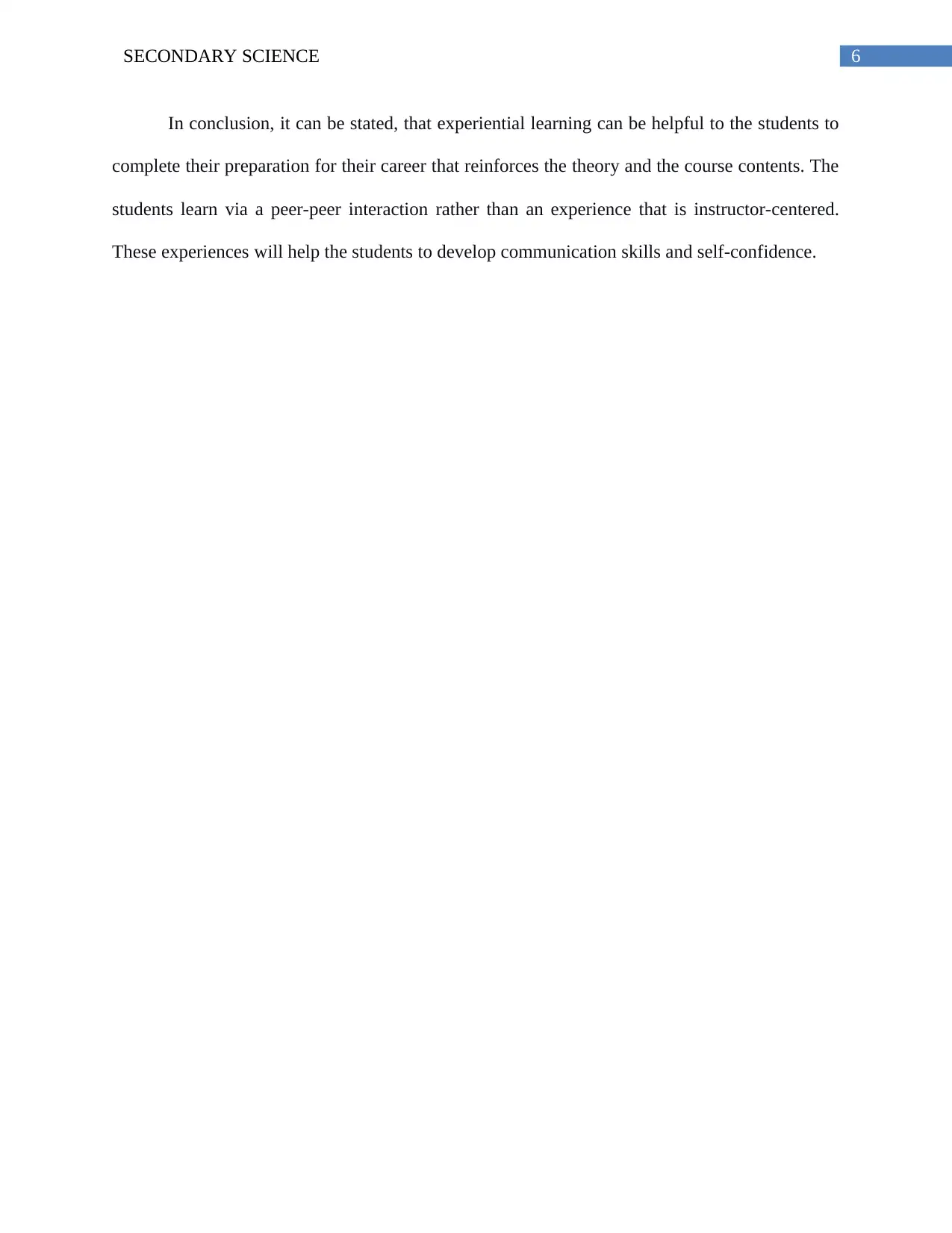
6SECONDARY SCIENCE
In conclusion, it can be stated, that experiential learning can be helpful to the students to
complete their preparation for their career that reinforces the theory and the course contents. The
students learn via a peer-peer interaction rather than an experience that is instructor-centered.
These experiences will help the students to develop communication skills and self-confidence.
In conclusion, it can be stated, that experiential learning can be helpful to the students to
complete their preparation for their career that reinforces the theory and the course contents. The
students learn via a peer-peer interaction rather than an experience that is instructor-centered.
These experiences will help the students to develop communication skills and self-confidence.
Paraphrase This Document
Need a fresh take? Get an instant paraphrase of this document with our AI Paraphraser
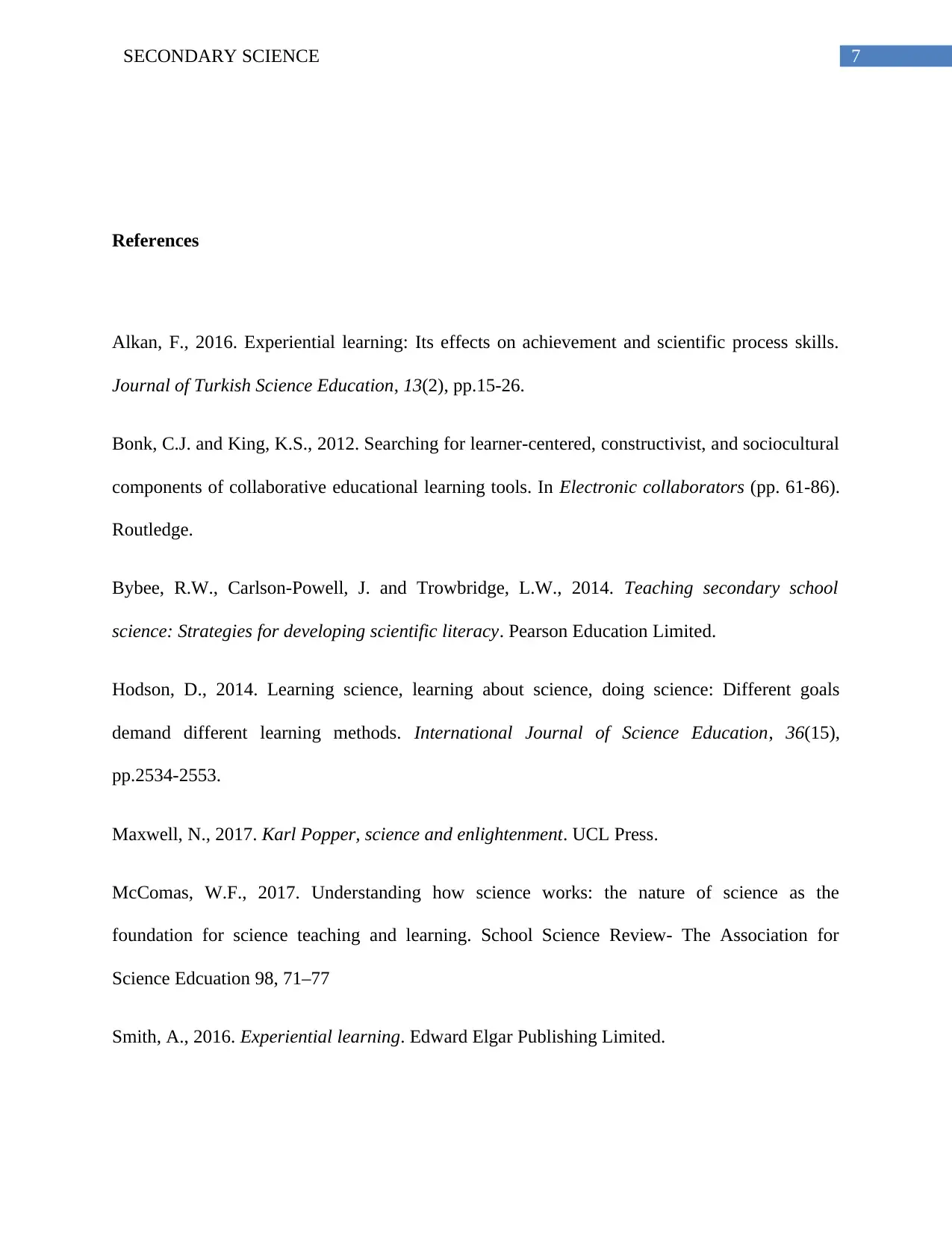
7SECONDARY SCIENCE
References
Alkan, F., 2016. Experiential learning: Its effects on achievement and scientific process skills.
Journal of Turkish Science Education, 13(2), pp.15-26.
Bonk, C.J. and King, K.S., 2012. Searching for learner-centered, constructivist, and sociocultural
components of collaborative educational learning tools. In Electronic collaborators (pp. 61-86).
Routledge.
Bybee, R.W., Carlson-Powell, J. and Trowbridge, L.W., 2014. Teaching secondary school
science: Strategies for developing scientific literacy. Pearson Education Limited.
Hodson, D., 2014. Learning science, learning about science, doing science: Different goals
demand different learning methods. International Journal of Science Education, 36(15),
pp.2534-2553.
Maxwell, N., 2017. Karl Popper, science and enlightenment. UCL Press.
McComas, W.F., 2017. Understanding how science works: the nature of science as the
foundation for science teaching and learning. School Science Review- The Association for
Science Edcuation 98, 71–77
Smith, A., 2016. Experiential learning. Edward Elgar Publishing Limited.
References
Alkan, F., 2016. Experiential learning: Its effects on achievement and scientific process skills.
Journal of Turkish Science Education, 13(2), pp.15-26.
Bonk, C.J. and King, K.S., 2012. Searching for learner-centered, constructivist, and sociocultural
components of collaborative educational learning tools. In Electronic collaborators (pp. 61-86).
Routledge.
Bybee, R.W., Carlson-Powell, J. and Trowbridge, L.W., 2014. Teaching secondary school
science: Strategies for developing scientific literacy. Pearson Education Limited.
Hodson, D., 2014. Learning science, learning about science, doing science: Different goals
demand different learning methods. International Journal of Science Education, 36(15),
pp.2534-2553.
Maxwell, N., 2017. Karl Popper, science and enlightenment. UCL Press.
McComas, W.F., 2017. Understanding how science works: the nature of science as the
foundation for science teaching and learning. School Science Review- The Association for
Science Edcuation 98, 71–77
Smith, A., 2016. Experiential learning. Edward Elgar Publishing Limited.
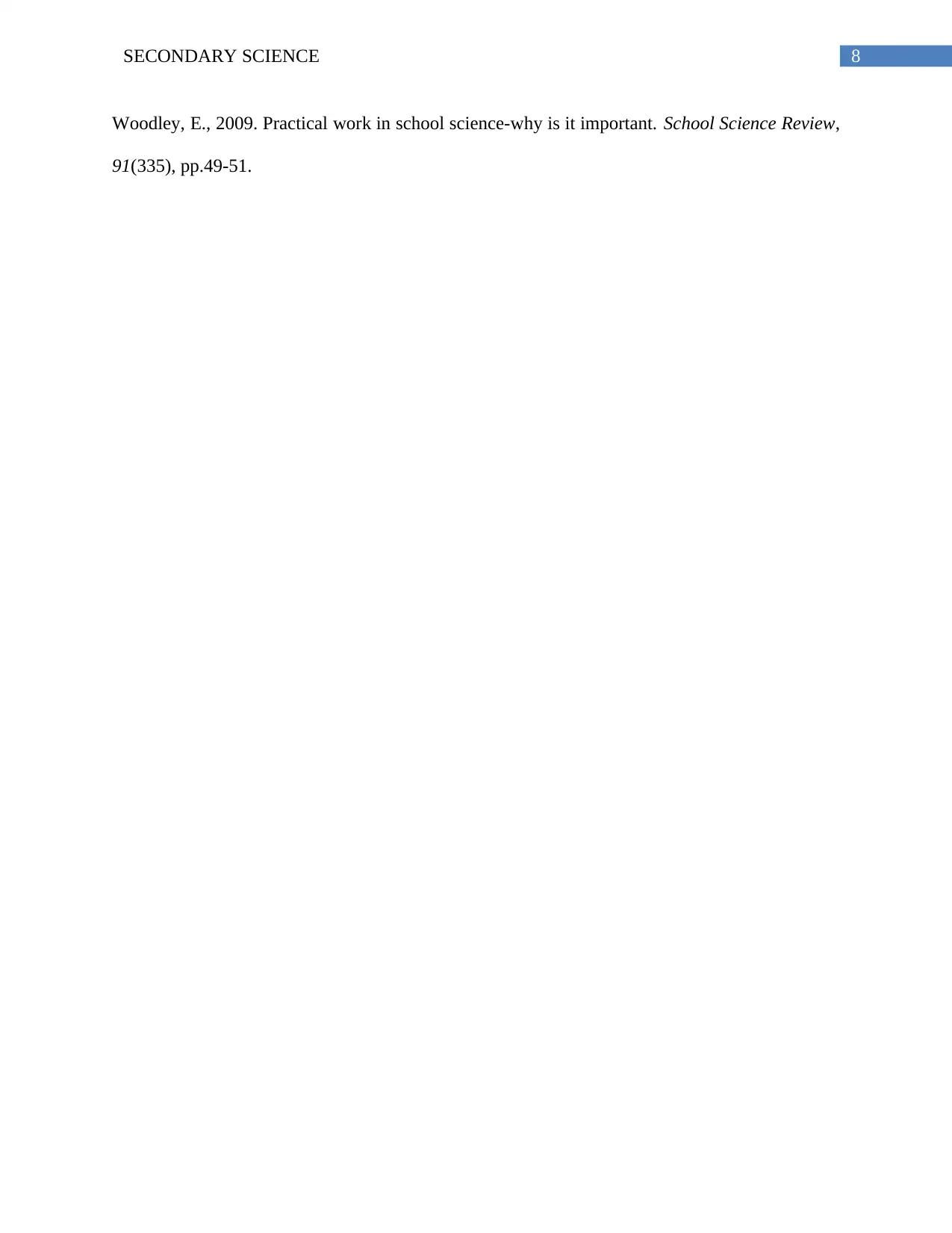
8SECONDARY SCIENCE
Woodley, E., 2009. Practical work in school science-why is it important. School Science Review,
91(335), pp.49-51.
Woodley, E., 2009. Practical work in school science-why is it important. School Science Review,
91(335), pp.49-51.
⊘ This is a preview!⊘
Do you want full access?
Subscribe today to unlock all pages.

Trusted by 1+ million students worldwide
1 out of 9
Related Documents
Your All-in-One AI-Powered Toolkit for Academic Success.
+13062052269
info@desklib.com
Available 24*7 on WhatsApp / Email
![[object Object]](/_next/static/media/star-bottom.7253800d.svg)
Unlock your academic potential
Copyright © 2020–2025 A2Z Services. All Rights Reserved. Developed and managed by ZUCOL.





